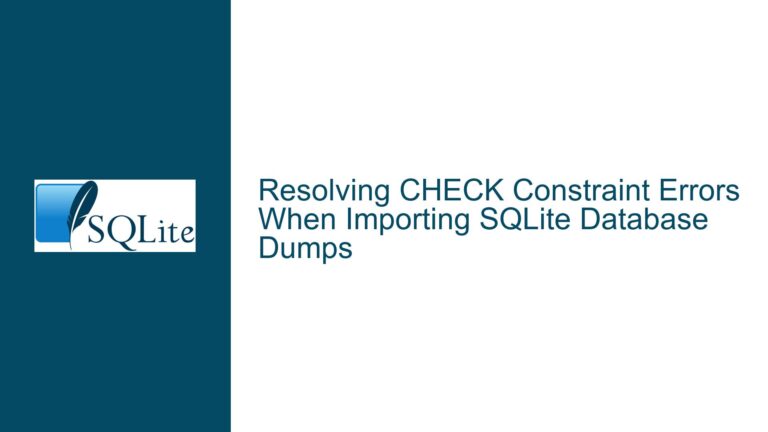Storing and Securing SQL Queries in SQLite-Based Application File Formats
The Role of SQL Queries in SQLite-Based Application File Formats
SQLite-based application file formats offer a unique advantage by embedding SQL queries directly within the database file. This approach allows developers to distribute predefined queries alongside the data, enabling users to perform complex data exploration and manipulation without requiring external tools or custom code. For example, a table named queries could store query names and their corresponding SQL statements, allowing applications to execute these queries dynamically. This design pattern is particularly useful for applications like outlining programs, puzzle solvers, or business automation tools, where users may need to perform repetitive or complex operations on the data.
However, this capability introduces both opportunities and challenges. On one hand, embedding queries simplifies application development and enhances user flexibility. On the other hand, it raises concerns about security, maintainability, and performance. For instance, malicious actors could alter stored queries to execute harmful operations, such as infinite loops or unauthorized data access. Additionally, poorly optimized queries could degrade application performance, especially when dealing with large datasets.
The discussion highlights the dual nature of stored SQL queries: they can significantly enhance functionality but also introduce risks if not properly managed. To address these challenges, developers must carefully consider how queries are stored, executed, and secured within SQLite-based file formats. This post explores the underlying issues, potential causes, and actionable solutions to ensure that stored queries are both useful and safe.
Risks and Benefits of Embedding SQL Queries in SQLite Files
Embedding SQL queries in SQLite-based application file formats offers several benefits, including improved usability, reduced development effort, and enhanced flexibility. For example, users can execute predefined queries to generate reports, filter data, or perform batch operations without writing custom code. This is particularly valuable in applications like puzzle solvers, where users might want to calculate the percentage of solved levels or select a random unsolved level. By storing these queries in the database, developers can provide a richer user experience while minimizing the need for external tools or libraries.
However, this approach also introduces significant risks. One major concern is the potential for malicious query modification. Since SQL queries are typically stored as plain text, they can be easily altered by anyone with access to the file. For example, a malicious actor could modify a query to execute a denial-of-service (DoS) attack by creating an infinite loop or to exfiltrate sensitive data by embedding unauthorized operations. These risks are exacerbated if the application loads extensions that enable file system access, network communication, or system calls.
Another challenge is ensuring query performance and reliability. Poorly written queries can lead to slow execution times or unexpected results, particularly when dealing with large datasets or complex schemas. Additionally, maintaining compatibility across different versions of the application file format can be difficult, especially if the schema or query logic changes over time.
To mitigate these risks, developers must implement safeguards such as query validation, digital signatures, and access controls. They must also carefully design queries to ensure optimal performance and reliability. By addressing these challenges, developers can harness the full potential of stored SQL queries while minimizing the associated risks.
Best Practices for Storing, Securing, and Optimizing SQL Queries in SQLite Files
To effectively store, secure, and optimize SQL queries in SQLite-based application file formats, developers should follow a set of best practices. These practices address the risks and challenges discussed earlier while maximizing the benefits of embedded queries.
Storing Queries Safely
One of the first steps is to ensure that queries are stored securely within the database. Instead of storing queries as plain text in a table, consider using a more secure approach such as encryption or digital signatures. For example, queries could be stored in an encrypted format, with the decryption key managed by the application. Alternatively, queries could be digitally signed to verify their authenticity and integrity. This would prevent unauthorized modifications and ensure that only trusted queries are executed.
Another approach is to store queries in a separate, read-only file that is distributed alongside the database. This file could be digitally signed and verified by the application before loading any queries. This approach reduces the risk of tampering while still allowing users to access predefined queries.
Validating and Sanitizing Queries
Before executing any stored query, the application should validate and sanitize it to prevent malicious or unintended behavior. For example, the application could check for prohibited keywords or operations, such as file system access or network communication. It could also enforce limits on query execution time or resource usage to prevent DoS attacks.
Additionally, the application should validate the query against the database schema to ensure compatibility and prevent errors. This is particularly important when dealing with user-specified queries, as users may inadvertently write queries that are incompatible with the current schema or produce unexpected results.
Optimizing Query Performance
To ensure optimal performance, developers should carefully design and test queries before embedding them in the database. This includes optimizing query logic, indexing relevant columns, and avoiding expensive operations such as full table scans or nested loops. Developers should also consider the size and complexity of the dataset when designing queries, as poorly optimized queries can lead to slow execution times or excessive resource usage.
Another important consideration is query caching. If the same query is executed repeatedly, the application could cache the results to improve performance. However, developers must ensure that the cache is invalidated when the underlying data changes to prevent stale results.
Maintaining Compatibility
As the application evolves, the schema and query logic may change, potentially breaking existing queries. To maintain compatibility, developers should version both the schema and the queries. For example, the database could include a version table that tracks the current schema version, and queries could be tagged with the version they are compatible with. When the schema changes, the application could automatically update or migrate queries to ensure they remain functional.
Providing User Flexibility
Finally, developers should consider how to provide users with the flexibility to write and execute their own queries. This could include providing a query editor or allowing users to assign SQL statements to key bindings, as described in the discussion. However, developers must ensure that user-specified queries are properly validated and sanitized to prevent security risks or performance issues.
By following these best practices, developers can effectively store, secure, and optimize SQL queries in SQLite-based application file formats. This approach enables powerful functionality while minimizing the associated risks, ensuring a safe and efficient user experience.
In conclusion, embedding SQL queries in SQLite-based application file formats offers significant benefits but also introduces challenges related to security, performance, and maintainability. By understanding these challenges and implementing best practices, developers can harness the full potential of stored queries while ensuring a safe and efficient user experience. Whether you’re building a puzzle solver, a business automation tool, or any other application that relies on SQLite, these insights will help you design a robust and secure file format that meets your users’ needs.






